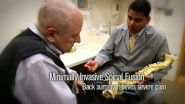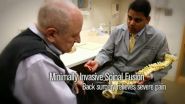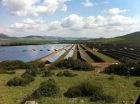Minimally invasive spinal fusion: Less pain, faster recovery, smaller scar
2015-03-16
(Press-News.org) MAYWOOD, Ill. (March 16, 2015) - A minimally invasive spinal fusion back surgery results in less blood loss, less postoperative pain, smaller incisions, a shorter hospital stay and faster recovery and return to work.
Rather than cutting through paraspinal (back) muscles, the surgeon spreads and dilates the muscles to obtain access to the lumbar (lower back) spine. One such operation is called a minimally invasive transforaminal lumbar interbody fusion (MIS TLIF).
It's a complex procedure with a steep learning curve, said Loyola University Medical Center spine surgeon Beejal Amin, MD, who has given talks about the procedure around the country. Dr. Amin is first author of an abstract and surgical video about the procedure in Neurosurgical Focus, a publication of the American Association of Neurosurgeons. (Click here to see the 3D video: http://youtu.be/LYRU9lbBdNg )
Dr. Amin learned the procedure while completing a fellowship in minimally invasive and complex spine surgery at the University of California at San Francisco Medical Center.
Patient William Hoecker is among Dr. Amin's patients who have greatly benefited from the procedure. Mr. Hoecker suffered debilitating leg pain and numbness due to degenerative spondylolisthesis and spinal stenosis. One vertebra had slipped forward over the vertebra below it, pinching the nerve root and causing pain in the left leg. For Mr. Hoecker, walking just 25 feet was so painful he would have to sit or lie down. He was unable to drive for more than 20 minutes. "I was stuck in my house," he said.
Dr. Amin fused the L4 and L5 vertebrae in Mr. Hoecker's lower back. First, he decompressed the spinal nerve roots. Next, he removed the degenerated disc between the two vertebrae. Then an implant filled with bone graft was placed in the empty disc space between the vertebrae. Dr. Amin implanted rods and screws to hold the vertebrae together. As the bone graft healed, it fused the two vertebrae together, resulting in a single bone.
The surgery dramatically improved Mr. Hoecker's quality of life. He now can walk or drive without limitations. Indeed, he's planning a road trip to Disneyworld, and is confident he will be able to keep up with his grandchildren.
INFORMATION:
Dr. Amin is an assistant professor in the Department of Neurological Surgery at Loyola University Chicago Stritch School of Medicine. In addition to minimally invasive spine surgery, Dr. Amin's specialties include back pain, cervical spine, complex spinal disorders, general neurosurgery, herniated disc, lumbar disc surgery, neck pain, peripheral nerve, spinal cord injury, spinal deformities and spinal tumors.
[Attachments] See images for this press release:


ELSE PRESS RELEASES FROM THIS DATE:
2015-03-16
Researchers have identified genes that may be involved in determining whether an individual is sensitive or resistant to rabies virus infection.
Through a screening method involving mouse embryonic stem cells, the investigators uncovered 63 genes, some with roles in the immune response, that represent potential targets for prevention or treatment. The wide variety of functions of the genes that were identified points to numerous interactions between the host and the virus at all stages of infection.
"Our study is the first to show that libraries of mutant stem cells ...
2015-03-16
Ecotourism has motivated efforts to reintroduce lions to landscapes where they were not previously common. A new analysis conducted after 4 lions were reintroduced into the fenced Tembe Elephant Park, South Africa, reveals that lions might compete with humans in winter, spring, and autumn and with endemic herbivores in all seasons but winter.
Despite the use of fencing to limit conflicts, communities that reintroduce carnivores continually balance the rewards associated with ecotourism and the risks to human safety and species conservation. The findings are published ...
2015-03-16
Contrary to common public perception, Canadian taxpayers could save billions by the introduction of a universal public drug plan to provide prescriptions to all Canadians, according to new research published in CMAJ (Canadian Medical Association Journal).
Canada is the only developed country with universal health insurance that does not also offer universal prescription drug coverage.
"A long-time barrier to the implementation of universal prescription drug coverage in Canada has been the perception that it would necessitate substantial tax increases," writes Dr. Steven ...
2015-03-16
Canada could save $7.3 billion annually with universal public coverage of medically necessary prescription drugs.
Canada is the only developed country with a universal health care system that does not include prescription drug coverage.
New research from the University of British Columbia and University of Toronto, published today in the Canadian Medical Association Journal , shows that universal public drug coverage, also known as universal pharmacare, is within reach for Canada even in times of government fiscal constraint.
"It's a win-win," said Steve Morgan, ...
2015-03-16
ANN ARBOR--Whether you're baking bread or building an organism, the key to success is consistently adding ingredients in the correct order and in the right amounts, according to a new genetic study by University of Michigan researchers.
Using the baker's yeast Saccharomyces cerevisiae, Patricia Wittkopp and her colleagues developed a novel way to disentangle the effects of random genetic mutations and natural selection on the evolution of gene expression. Their findings are scheduled for online publication in the journal Nature on March 16.
"These results tell us that ...
2015-03-16
A new study from the University of Birmingham and the MRC Cognition and Brain Sciences unit in Cambridge has shown how intentional recall is beyond a simple reawakening of a memory; and actually leads us to forget other competing experiences that interfere with retrieval. Quite simply, the very act of remembering may be one of the major reasons why we forget.
The research, published today in Nature Neuroscience, is the first to isolate the adaptive forgetting mechanism in the human brain. The brain imaging study shows that the mechanism itself is implemented by the suppression ...
2015-03-16
The largest genetic study of tuberculosis (TB) susceptibility to date has led to a potentially important new insight into how the pathogen manages to evade the immune system. Published today in the journal Nature Genetics, the study advances understanding of the biological mechanisms involved in TB, which may open up new avenues to design efficient vaccines for its prevention.
TB, caused by infection with the pathogen Mycobacterium tuberculosis, is a major global public health problem. According to the World Health Organization, in 2013 nine million people fell ill with ...
2015-03-16
A Venezuelan evolutionary biologist and a US zoologist state that they have refuted, through mitochondrial DNA sequencing, a recent claim, also based on such sequencing, that unknown type of bear must exist. in the Himalayas and that it may be, at least in part, the source of yeti legends. Their study was published in the open access journal ZooKeys.
Last year, B. Sykes and co-authors, in the course of mitochondrial DNA sequencing identification of hair samples that had been attributed to "anomalous primates" (yetis, bigfoots, and others), claimed to have found that ...
2015-03-16
Berkeley -- Hard-wiring beetles for radio-controlled flight turns out to be a fitting way to learn more about their biology. Cyborg insect research led by engineers at the University of California, Berkeley, and Singapore's Nanyang Technological University (NTU) is enabling new revelations about a muscle used by beetles for finely graded turns.
By strapping tiny computers and wireless radios onto the backs of giant flower beetles and recording neuromuscular data as the bugs flew untethered, scientists determined that a muscle known for controlling the folding of wings ...
2015-03-16
In the face of global climate change, increasing the use of renewable energy resources is one of the most urgent challenges facing the world. Further development of one resource, solar energy, is complicated by the need to find space for solar power-generating equipment without significantly altering the surrounding environment.
New work from Carnegie's Rebecca R. Hernandez (now at University of California Berkley), Madison K. Hoffacker, and Chris Field found that the amount of energy that could be generated from solar equipment constructed on and around existing infrastructure ...
LAST 30 PRESS RELEASES:
[Press-News.org] Minimally invasive spinal fusion: Less pain, faster recovery, smaller scar



